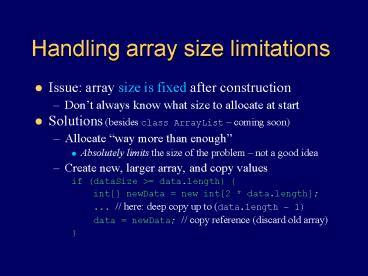Handling array size limitations PowerPoint PPT Presentation
1 / 10
Title: Handling array size limitations
1
Handling array size limitations
- Issue array size is fixed after construction
- Dont always know what size to allocate at start
- Solutions (besides class ArrayList coming soon)
- Allocate way more than enough
- Absolutely limits the size of the problem not a
good idea - Create new, larger array, and copy values
- if (dataSize gt data.length)
- int newData new int2 data.length
- ... // here deep copy up to (data.length
1) - data newData // copy reference (discard
old array)
2
Arrays of object references
- Arrays of objects require 3 steps to use
- Rectangle boxes // 1. declare array of
references - boxes new Rectangle3 // 2. instantiate array
- for (int i0 iltboxes.length i)
- // 3. instantiate each object in the array
- boxesi new Rectangle(5i, 5i, 5, 5)
- Two ways to copy (like any object that has
references to other objects) - Shallow copy just copies array references
- Deep copy makes new copies of all objects
3
Arrays of arrays
- e.g., int a new int104
- Like a table with 10 rows and 4 columns
- a.length is 10
- Each ai.length is 4, for all i
- Component array sizes can vary
- a2 new int6 // now 3rd row has 6
- Typically use nested for loops to process
- See TicTacToe.java (p. 307)
4
java.util.ArrayList
- ArrayListltTgt a new ArrayListltTgt()
- T is an object type may not be primitive
- A generic class (since Java 5) so type safe
- Use methods to add, insert, remove, set, get
- Cannot use or notation like arrays
- Use wrapper classes for primitive data types
- Btye, Short, Integer, Long, Float, Double,
Character, Boolean - Autoboxing and auto-unboxing simplifies it though
- ArrayListltDoublegt list new ArrayListltDoublegt()
- list.add( 0.74 ) // actually adds new
Double(17.64) - double d list.get(0)
- // actually executes list.get(0).doubleValu
e()
5
How to use ArrayLists
- Declare/create ArrayList (no need to size it)
- ArrayList a new ArrayList()
- Or with Java 5 can specify the type
- ArrayListltTgt a new ArrayListltTgt()
- // where T is an object type not a primitive
data type - Add objects to end, or set and get specific
objects - ArrayListltRectanglegt a new ArrayListltRectanglegt(
) - a.add(new Rectangle(5,5,5,5))
- Rectangle r a.get(0) // gets first
- a.set(0, new Rectangle(0,0,10,10)) // replaces
first - Simple insert and remove too
- a.insert(i, new Rectangle(1,1,1,1)) // inserts
in position i - a.remove(i) // removes element in position i
6
Sample Quiz
- (10 points) Let x be an array of double that is
already initialized. Create an ArrayListltDoublegt
object, and copy each x value to this list in
reverse order (add the last element first, , and
the first element last) . - (10 points) Let y be an array of double
arrays that is already initialized. Translate the
following nested enhanced for loops to nested
while loops - for (double row y)
- for (double value row)
- System.out.println(value)
7
1st Quiz 20 homework points
- (8 points) Let x be a double array that is
already initialized. Translate the following
enhanced for loop to a while loop - for (double d x)
- System.out.println(d)
- (12 points) Let y be an array of double
arrays that is already initialized. Declare and
create an ArrayListltDoublegt named list, and add
copies of every value in y to list (the order
does not matter).
8
More java.util collections
- List actually an interface
- Defines a set of common methods like add, size,
iterator - Shared by ArrayList, LinkedList, and others
- Note Collections methods to manipulate List
objects - Collections.shuffle(list) // randomly shuffles
the list - Collections.sort(list) // assuming items are
Comparable - Stack a last-in first-out (LIFO) data structure
- StackltStringgt s new StackltStringgt()
- s.push(dog) ... // push objects onto top of
stack - while (!s.isEmpty())
- ... s.pop() // removes/returns top
object - Also trees, sets, hash tables, more about
this in CS 20
9
Using methods invoking
- Can look like a direct translation of an
algorithm - getData()
- process()
- showResults()
- Then process() might use another method
- result calculate(x, y)
- where calculate returns a value based on x and
y. - And so on
- Translates top-down program design to method calls
10
Invoking methods (in formal terms)
- methodName(list of arguments)
- Transfers control to the method named may pass
data via the list of arguments - After the method completes (or aborts) its work,
control returns to the calling statement - Some methods also return some results
- Actual syntax objectReference.name()
- Or ClassName.name() if method is declared static
- In same class, this. is implied

